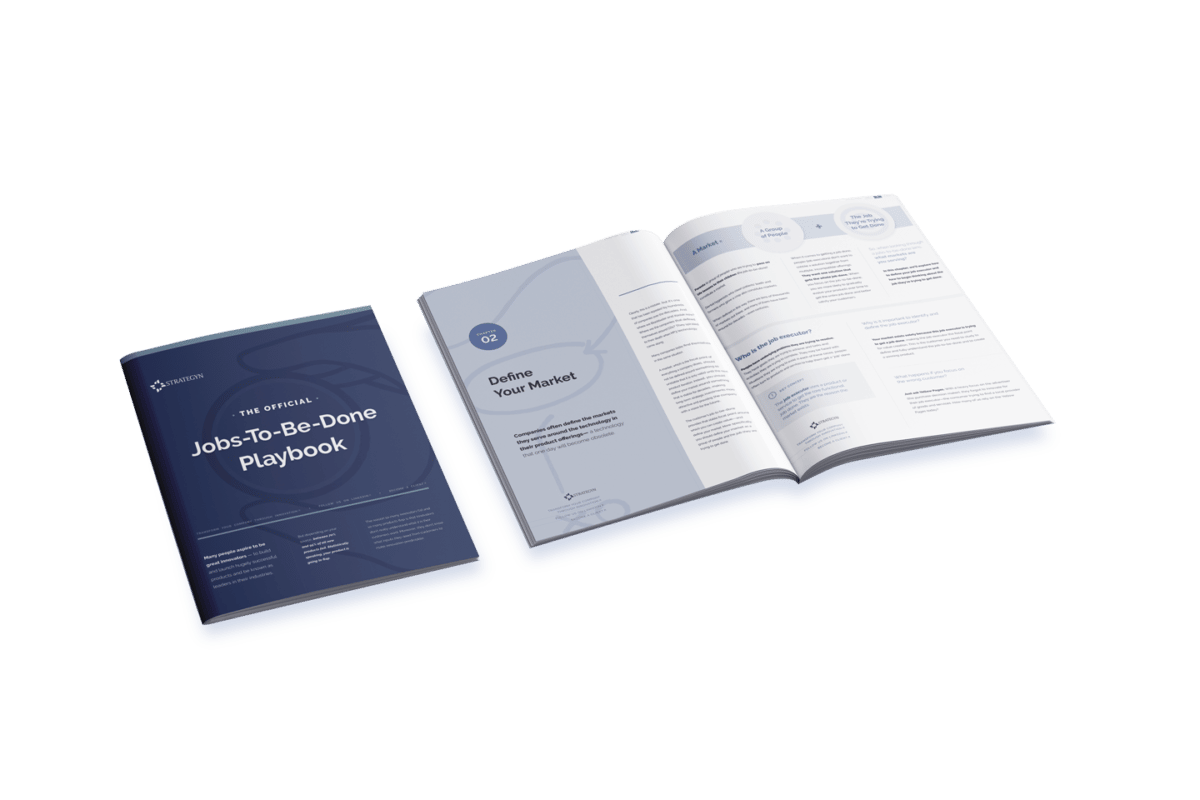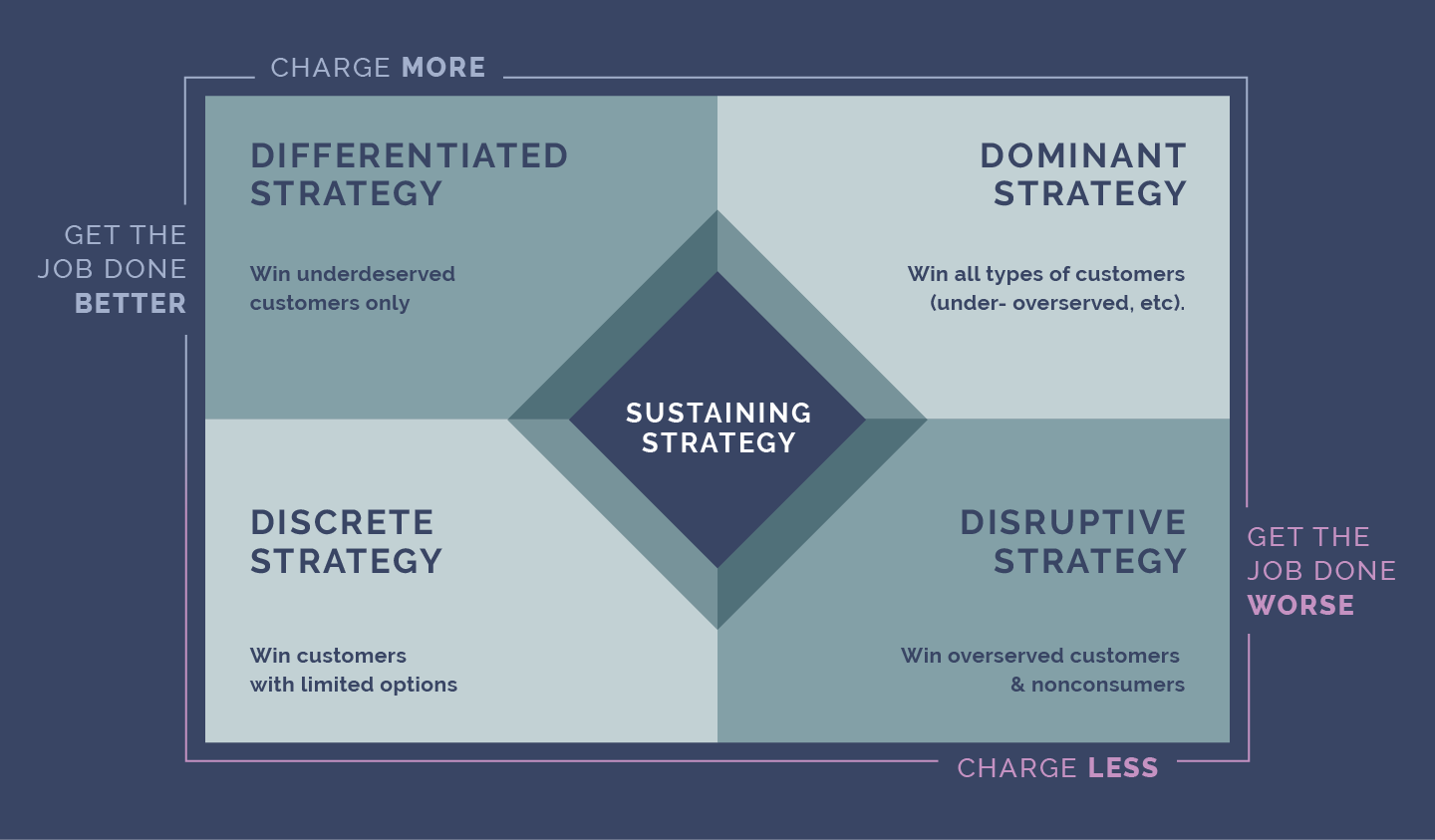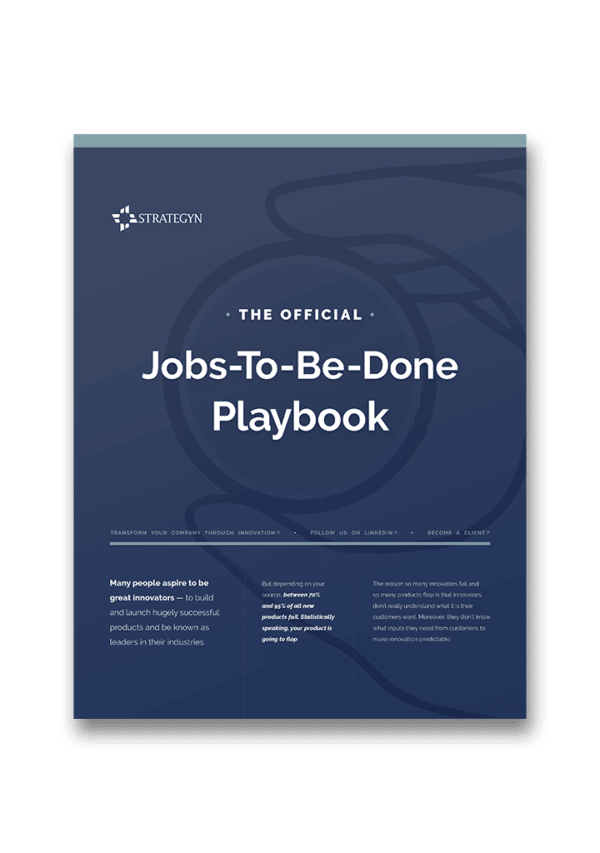In short, using a Jobs-to-be-Done lens, you can take your understanding of customer needs to the next level. And with the right customer inputs, you can orchestrate the systematic creation of customer value across the organization.
This chapter explains nine tenets of Jobs-to-be-Done Theory and prepares you for applying these tenets to grow your own business. You’ll also find out how Arm & Hammer used these tenets to turn around a streak of lackluster product launches — and grow 30%+ year-over-year.
When looking at marketing and innovation through a jobs-to-be-done lens, a theory begins to emerge.
Jobs to be Done theory consists of a group of principles or tenets that form a foundation for making marketing more effective and innovation more predictable by focusing on the customer’s job-to-be-done.
The theory is based on the notion that people buy products and services to get a “job” done. Jobs Theory goes on to say that by understanding in detail what that “job” entails, you are far more likely to create and market solutions that will win in the marketplace.
Each of these tenets brings new insights into your company’s business practices — increasing the organization’s ability to create and market breakthrough products and services. Let’s look at each in more detail.

Download your free copy of The Official Jobs-to-be-Done Playbook.
People have underlying problems they are trying to resolve. They have goals they are trying to achieve and tasks and activities they are trying to complete. They may be faced with situations they are trying to avoid. In each of these cases, people often turn to products and services to help them get a “job” done.
A job is not a description of what the customer is doing, the solution they are using, or the steps they are taking to get a job done. Rather, the job is what the customer is ultimately trying to accomplish. The core job-to-be-done is defined as a “functional job.”
When you define a market this way, you clarify your target customer and the job you are going to help the customer accomplish with your product or service offering.
As a customer uses a product or service to get a functional job done, they often want to feel a certain way or be perceived in a certain light by their peers, friends or others. The ways they want to feel and be perceived are called emotional and social jobs-to-be-done.
For example, when parents are trying to pass on life lessons to children (the functional job-to-be-done), they may also want to feel like they are contributing to the advancement of society or want to be perceived as good parents by their peers.
A functional job-to-be-done is often something people have been trying to accomplish for years, decades—or even centuries. Parents, for example, have been trying to pass on life lessons to children since the beginning of humanity.
What changes are the products and services that companies offer to help get the job done better.
Because the job-to-be-done is stable over time, it is an attractive focal point around which to create customer value for many years. With this in mind, your business’ strategy should always be to help customers get the entire job done better and more cheaply on a single product platform. This is the long-term strategy that Amazon has pursued since its inception.
The core functional job is solution agnostic —this means it is independent of any solutions or technologies.
Innovation isn’t about “a faster horse.” A “horse” is a solution to get a job done. The job (transporting yourself from point A to point B) must be defined independently of the solution (the horse). This is how new, breakthrough solutions can be conceptualized (like the automobile).
Customers don’t know what solutions will get a job done best — they couldn’t envision the car or the microwave or the smartphone. But customers do know what job they are trying to get done and can tell you all about it.
Lastly, since the job-to-be-done is solution agnostic, competitors are not only companies that make products like yours. They are any solution (paid and non-paid) that customers use to get the core job done. For example, the bicycle and the car are competing solutions for the job of getting from point a to point b.
Making the job-to-be-done the unit of analysis means it is the job — not the product, the customer, the circumstance, the purchase process or customer demographics — that you need to study, dissect and understand at a granular level of detail.
Since the customer’s job-to-be-done is stable over time, the customer’s needs, when defined as desired outcome statements, are also stable over time.>With a stable set of “needs” in hand, you can:
Knowing which product or service concept will get the job done best early in the product planning stages (prior to development), is the key to predictable and profitable innovation.
We have learned that people aren’t loyal to companies or brands. They are loyal to getting a job done better (faster, more predictably, and with higher output/throughput) and/or more cheaply. They replace existing products and services with those that help them achieve these goals.
We have learned that some people are willing to pay more to get a job done better, while others are willing to pay less to get a job done worse. Knowing what types of customers exist in your market (and in what proportions) forms the foundation for a new way to think about your growth strategy.

There are many products and services available in the market that only get part of a job done. Customers are left to cobble together solutions in order to get the entire job done. But customers don’t want to cobble together the solution. They want a complete solution presented to them.
Your goal should therefore always be to help your customers get their entire job done on a single platform.
And you can accelerate this process once you know exactly what steps the customer goes through to complete the job.
Nespresso is a great example. The company worked for years with a single strategy in mind: to enable customers to get the job of “preparing a hot beverage for consumption” done on a single platform.
Let’s jump back to the animal nutrition team at Arm & Hammer.
This business provides animal nutrition, animal productivity, food processing, and safety solutions. Just like other businesses in the industry, they had been relying on animal nutrition consultants to inform their product innovations.
But when they applied Jobs Theory , they realized they were looking at their market and customers all wrong.
First, their real customer was the dairy producer, not the nutritionist. By shifting the focus to this customer, Arm & Hammer was able to understand the “job” the dairy producer was trying to get done had little to do with nutrition — and was squarely focused on optimizing dairy herd productivity. The market they were in was dairy producers (a group of people) trying to optimize dairy herd productivity (job-to-be-done).
With this new insight, Arm & Hammer interviewed a dozen dairy producers and uncovered 165 unique desired outcome statements the dairy producer was trying to satisfy. The team then surveyed more dairy herd producers to quantify the degree to which each outcome was under- or overserved by existing products in the market. This was the data they needed to guide their decision making around their new products and take the guesswork out of their innovation process.
The team was surprised to see how many opportunities there were — and how few of them were directly related to nutritional ingredients. These insights told the team to build a new messaging strategy that focused on the specific outcomes that would deliver value to the dairy producers, rather than their traditional approach of focusing on nutritional features.
This change in messaging strategy alone led to year-over-year revenue growth of 30%+.
As Arm & Hammer VP Scott Druker explained.
We started to see results from our new messaging and positioning strategy almost immediately. It contributed to an outstanding year. In the end, we grew greater than 30%…. Every one of our products had double-digit growth. We far outpaced our competitors.
SUMMARY OF INSIGHTS FROM JOBS-TO-BE-DONE THEORY
When your company thinks about a market from this perspective, you are much more likely to create and deliver extraordinary products and services. Product managers can more successfully conceptualize new products, improve existing products, and prioritize backlog, for example. Marketing managers can use this approach to design web pages, campaigns, and sales pitches that convert, and create content that attracts leads. Executives have the insights they need to align the organization around a common vision, inform M&A activity, and discover new markets to enter.
All thanks to a new lens and a better understanding of the customer’s needs .
WHAT’S NEXT?
At this point, you’re probably wondering how you can get started with applying these tenets to your own marketing and innovation practices.
In the next chapter of this playbook, you’ll learn how to identify your real customer and frame their job-to-be-done — just like Arm & Hammer did. We’ll include more case examples, as well as downloadable tools to help you along in the process.

Copyright ©2024 Strategyn LLC. All Rights Reserved. | Sitemap